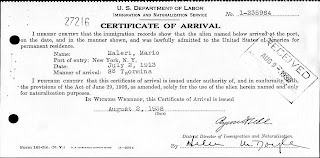 |
| ID photo from a Petition for Naturalization |
Genealogists know how to pull tons of facts from a well-written obituary. I documented Doc's family names and relationships in my family tree software.
Using these new pieces of information, I searched for his father Mario's arrival in the United States from Italy.
Mario's naturalization documents are among the richest I've found. Let's go through them to see how much you can learn about an immigrant ancestor through their naturalization papers.
Certificate of Arrival
When an immigrant wanted to become a citizen in the early 1900s, they provided information about their arrival into the U.S.:
 |
| Certificate of Arrival |
- date of arrival
- port of entry
- name of ship
That's a boon to your family tree research right there. In Mario's case, the documents include a Certificate of Arrival that verifies these facts.
This certificate gives you, the family tree researcher, exactly the information you need to find Mario's ship manifest. There you can gather information that may include his father or mother's name and his town of origin.
Declaration of Intention
This form has so many vital facts packed into a small area. In Mario's case, we learn his:
- address
- occupation and age
- physical description
- town of birth
- birth date
- wife's name and date and place of birth
- wedding date
- children's names and birth dates
Mario's arrival information, confirmed on the Certificate of Arrival, is repeated here. Plus we see his signature and photograph.
Petition for Naturalization
 |
| Enough data to make a genealogist weep. |
So if you are able to find one, but not both of these detailed forms for your ancestor, you've still found a genealogical treasure.
If your ancestor had a spouse and children at the time of their declaration and petition, you now have an official source of their vital information.
Mario's paperwork provided me with Doc's real name and birth date, as well as those of his brothers, whom I didn't know. With these facts I can fan out my search for census forms, Social Security Death Indexes, and other records of this family.
Perhaps most excitingly, I can search for documents from Mario's hometown in Italy and try to extend his family history there.
Naturalization records are available through the U.S. Naturalization and Records Administration (searchable online), Ancestry.com and FamilySearch.org.
The sheer density of critical vital information makes genealogists absolutely adore our immigrant ancestors.
And speaking of immigration:
No comments:
Post a Comment
You may leave an anonymous post if you have no Google account. The author screens each comment for spam before it appears here. So don't bother to spam.